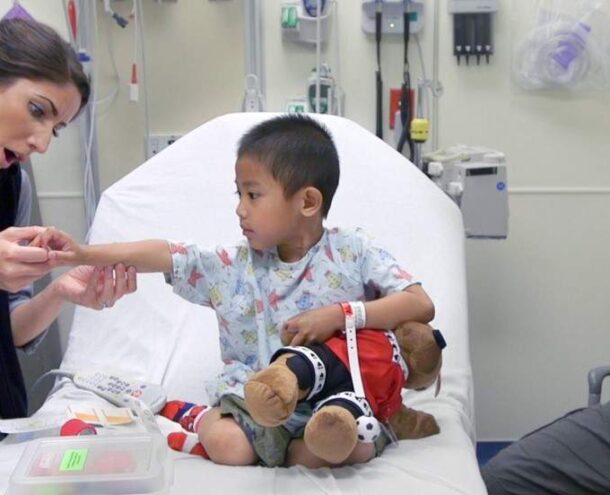Aligning Space, Staff, and Services for an Optimal Healthcare Experience

Space, staff, and services: To create human-centered healthcare experiences, all three must work together.
Improving experience through behavioral solutions
As a mother of two young sons and the former owner of a clear, acrylic coffee table, I’ve had the unfortunate luck of not one, but two recent trips to the ER.
These visits took place at two different hospitals, with two almost identical experiences. Both hospitals were what you would expect: cold lighting, non-existent wayfinding, and clinical space design with limited access to daylight. The small patient areas were filled with scary looking devices and lined with flimsy curtains — meaning we could overhear the crying of nervous children and the whispers of worried grown-ups while we anxiously awaited our turn.
Archaic check-in rituals — when will filling out vaguely specific forms on a clipboard finally become a thing of the past? — along with loud noises, unhealthy vending options, and long wait times added to the nervous energy of each experience.
Learn More: Integrating Brand Elements into Physical Space to Elevate Experience
However, even with all their similarities, the second ER visit was infinitely better than the first. Why? A staff role. In this setting, there was a dedicated staff member, who was not a nurse or a doctor. Their sole job was to engage my child directly throughout the visit, with toys, light spinners, songs, and everyone’s favorite: Paw Patrol. This freed up the doctor and nurses to do their job efficiently, while enabling me to do my job of being a loving parent. And, as a result, my son remained calm, supported, and distracted during the entire procedure.
What was their role? They were a Child Life Specialist.

Incorporating this role into my son’s care was a simple solution that completely transformed our experience in the ER. Consider its scalability: whether training a dedicated individual in a larger setting or cross-training staff in a smaller environment, bringing in these types of staff roles has the potential to change the perception of a space that’s often inherently unappealing—and instead create a memorable experience that drives patient (and parent!) happiness.
When virtual options transcend physical space altogether
Behavioral solutions like these aren’t the only forms of recent innovation in the healthcare industry. When the pandemic exposed the limitations of traditional, physical healthcare systems, newer players and start-ups in the field of telehealth really began to thrive.
Learn More: Humanizing Brand Experience Vol 4 Report
One of these companies is Forward. It delivers highly personalized, data-driven health monitoring that’s provided, in part, through virtual, remote care. Members can complete much of their first doctor’s visit from the comfort of their own homes with the Forward at Home service, which includes a sensor kit, in-home blood draw, and other digital tools. Forward’s groundbreaking offering is designed to transcend the need for physical space, allowing its offering to be both nimble and scalable. In this case, physical space itself has the freedom to become more experiential.

Intentional, community-focused design
On the other hand, well-considered physical space that feels connected to the communities it serves can positively impact healthcare experiences. Created by Silver Thomas Hanley and Bates Smart, Bendigo Hospital in Australia achieves just that. Courtyards, balconies, skylights, and window-lined corridors give staff and patients a constant view outside. All of these areas are joined together by an ‘internal street’ that acts as the entrance and main thoroughfare of the building. These natural, light-filled, and welcoming spaces also feature colorful, custom graphics that depict the flora and fauna of the region—celebrating the building’s location in a unique and engaging way.

At Bendigo, design isn’t only focused on how the space looks—it cares even more about how its spatial elements made people feel. From the ground up, the whole experience is intended to create a sense of community and wellness—moving far past the expectations of typical healthcare spaces.
Learn More: The New Spaces of Healthcare
Space as a service
What happens when you use physical space to create a new and different kind of product or service? Boston Medical Center implemented a 2,700-square-foot garden and roof terrace that supplies its kitchen and food pantry with fresh produce. What’s more? The hospital also uses the produce to stock a food pantry, provide patients who are financially struggling with subscriptions for healthy produce at no cost, and teach employees, patients, and their families how to cook nutritious meals through free classes.
It’s a move that demonstrates space doesn’t have to be used in a conventional way to make an impact. Here, Boston Medical Center repurposed a functional, unused space (the roof) to ultimately create additional services for its patients. And these types of services help build trust—which ultimately encourages people to continue using and recommending an organization.

When a brand experience goes beyond a single space, facility, or physical touchpoint in a consistent way, that’s when the magic happens. To bring these memorable moments to life, keep some of the following questions in mind:
-
-
- How can I integrate products, services, and behaviors into my space and brand experience to drive patient and visitor wellbeing?
- How can I streamline customer data to communicate between facilities?
- How can I create a personalized and memorable brand experience that fosters trust?
- How can I ensure my employees are happy and supported to deliver the best possible patient experience?
- How can I take advantage of a wide range of facility types and embed touchpoints into them that deliver a holistic customer experience?
-
By designing for human needs along the end-to-end brand experience, you can find new opportunities to augment your space—and surprise and delight the people you serve in the process. After all, a smart staff role still has my youngest son asking to go to the hospital every time he gets a boo-boo.
This article was authored by Alison More, Senior Creative Director of Environments and Experience at Monigle. For over 15 years, Alison has been focusing on the role environments play in enabling experience and has done so for brands such as Tiffany & Co, Nike, Chevrolet, and Citibank. Her expertise is rooted in blending physical, digital, and human touchpoints—creating holistic environments that not only deliver on design, but activate what people think, feel, and do.



